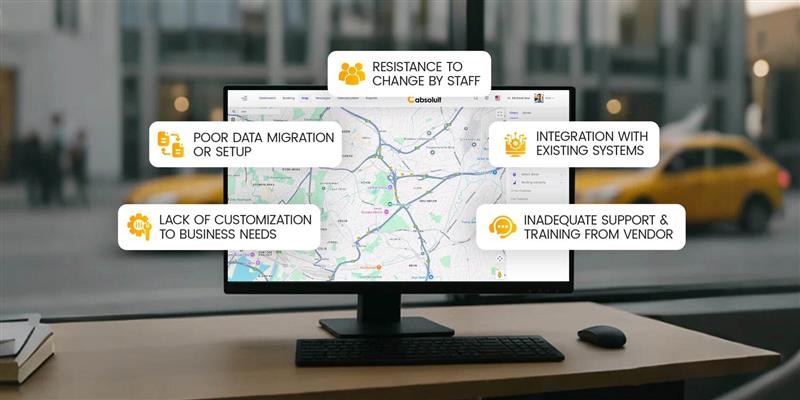This paper discusses the five most typical problems that are encountered by taxi companies and provides viable solutions to remedies. These are not generic tips. They deal with the issues that appear in everyday activities.
Should you have had experiences of delays, bookings made twice, or you find it hard to organize your team, this will assist you to identify what is holding things back and what you can do about it. These problems become the basis of the systems of such companies as Cabsoluit to assist the dispatch teams operate in a better and more organized way.
1. Resistance to Change by Staff
Why it occurs:
Most dispatch teams resist new systems either due to fear, no training, or due to familiarity with the old ways of doing things.
Other employees fear that they will be driving home with technology. Others do not just desire to leave the manual procedures that they have been practicing over the years.
Impact:
There is a high chance of underutilization of a new system as staff always oppose change.
Features may be overlooked by dispatchers who might then proceed with slowness, confusion and minimal payoff on your investment.
Related Article: 5 Signs Your Taxi Business Needs a Taxi Dispatch Software
Related Article: Building vs Buying Taxi Software: The Smarter Investment?
Solutions:
- Engage with the team during the decision-making process. Allow them to put it to the test, provide feedback, and know why the switch is being made.
- Conduct onboarding and training programs that emphasize actual tasks they deal with on a daily basis.
- Provide follow-up and mini rewards to promote learning and continued use.
Hack:
Choose a system with a clean and easy to use design. With a user interface that is easy to use and navigate, Cabsoluit is easy even for non-technical users and thus the transition becomes less stressful for all.
Related Article: The Evolution of Taxi Dispatching: Manual Vs Automated Systems
Related Article: How AI Can Change the Taxi Industry
2. Integration with Existing Systems
Challenge:
One of the challenges usually faced during the transition to a new dispatch platform is that it might not integrate well with the current tools.
Most taxi companies continue to employ older systems in the areas of billing, customer records, GPS tracking, and payroll. In case the new software is not compatible with these tools, it generates additional work.
Why it is important:
In the absence of proper integration, the teams usually find themselves entering the same information on several occasions. This slows down the process, creates the risk of making mistakes, and causes service gaps
To illustrate, a reservation agent can update a booking on one system, but the update may not be reflected on the GPS on the driver or on the invoice of the customer.
Related Article: How to Choose the Best Taxi Dispatch Software in 2025
Related Article: Top 10 Best Taxi Dispatch Softwares In 2025
Solutions:
- Give preference to those platforms where there are open APIs or in-built integration opportunities. This enables the new system to co-exist with your existing tools without any tensions.
- Select suppliers with the ability to integrate customs. They are able to modify the software to suit your specific configuration rather than compelling anyone to use a universal solution.
Why Cabsoluit:
Cabsoluit simplifies taxi operations with smart dispatching, real-time GPS tracking, and easy driver and passenger apps. It offers multi-channel booking, flexible payments, and a centralized dashboard. With customization, analytics, and 24/7 support, Cabsoluit ensures efficiency, safety, and scalability for modern taxi businesses.
3. Poor Data Migration or Setup
Issue:
The movement of the data in the old system is one of the least considered ones when switching to a new dispatch system.
When the migration process is not planned or fast, it tends to give sloppy records and information losses.
Symptoms:
Symptoms of bad data migration may include lost customer history, wrong driver or vehicle details, or overlapping schedules.
Such mistakes do not just make things slow down but can cause service failures as well as billing mistakes and frustrated customers.
Solutions:
- Start with a full data audit. It is good to clean up old records, get rid of duplicates, and arrange your files before moving anything.
- Apply the migration tools or services offered by vendors. A trusted software vendor must assist you in importing your data in a secure and correct manner no matter you have a small fleet or large one .
- Check them all in advance. Make trial bookings, assign checks and ensure that everything is coming out where it should.
Pro-tip:
Ensure that your provider has on-the-job assistance. Cabsoluit has guided data migration support, which assists in the transfer of information without much disruption of the daily operations.
4. Lack of Customization to Business Needs
Problem:
A large number of dispatch systems are designed in a one-size-fits-all manner. That may be true in the case of some but does not always suit the requirements of various operations.
A delivery service cannot operate like a taxi company and vice versa, and some of these platforms are supposed to do so.
Consequence:
When the software cannot be modified, teams are forced to commit the teams to strict systems. This brings about confusion, procrastination of tasks and unnecessary procedures which could not be there.
In the long run, employees are likely to abandon certain elements of the platform.
Solutions:
- Search in a platform that has flexible workflows or modular features. This way you can switch on what you need and switch out what you don’t want.
- Inquire about personalization or interface modification. Good vendors can be flexible in how the software fits your team.
Why Cabsoluit:
Cabsoluit is meant to be adjustable. Flexible enough to suit a taxi operator, it is modular and can be customized to your requirements, without requiring you to alter the nature of your operations.
5. Inadequate Support & Training from Vendor
Problem:
Only when your team understands how to use a good dispatch system can it be helpful. However, the trouble is that lots of vendors do not meet the expectations as soon as the purchase is made. The users are left to guess without proper training or good support.
Risk:
There is the risk of stalled implementation, unaddressed bugs, and not understanding how to use features due to inadequate support. Once problems accumulate, the users are no longer confident in the system and can revert to the old ways.
Solutions:
- Assess the vendor’s support requirements prior to purchasing. Ensure they have transparent service-level agreements, response times, and escalation channels.
- Select a provider with complete onboarding, continued support, and guides or video demonstrations. It is also desirable to have round-the-clock support particularly when operations are late or 24/7.

Take advantage of in-built reports or analytics applications to identify delays, bookings, and unused features. The minor improvements over time can result in significant changes in speed, accuracy, and quality of service. Optimization should be a continual process in the most efficient fleets.
Conclusion
There are also challenges that accompany a smooth dispatch operation, and each of them has an evident solution. These roadblocks are the result of staff resistance to integration problems, data migration challenges, customization and poor vendor support, but they can be addressed.
With the right tools, prepping your team and a vendor that really knows your needs, you can create a system that will work to the satisfaction of all parties. These are not indications of surrender. They are chances to make your business better in its daily operation.




